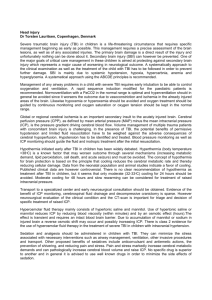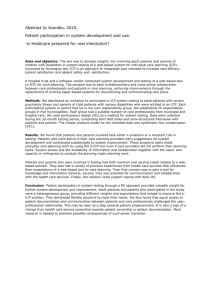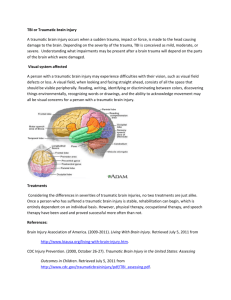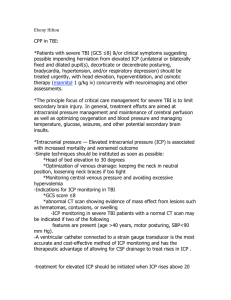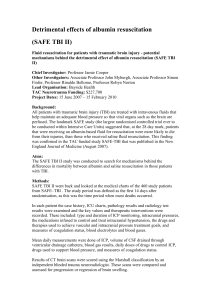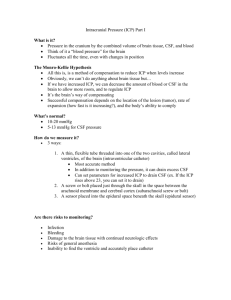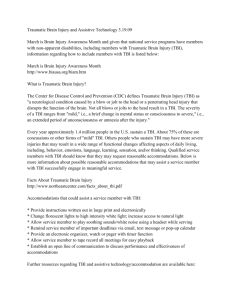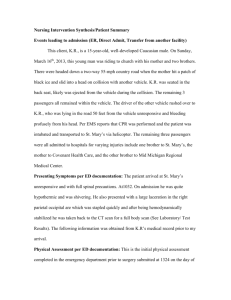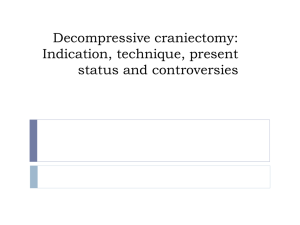TBI: Pathophysiology and Management * in 30 minutes
advertisement
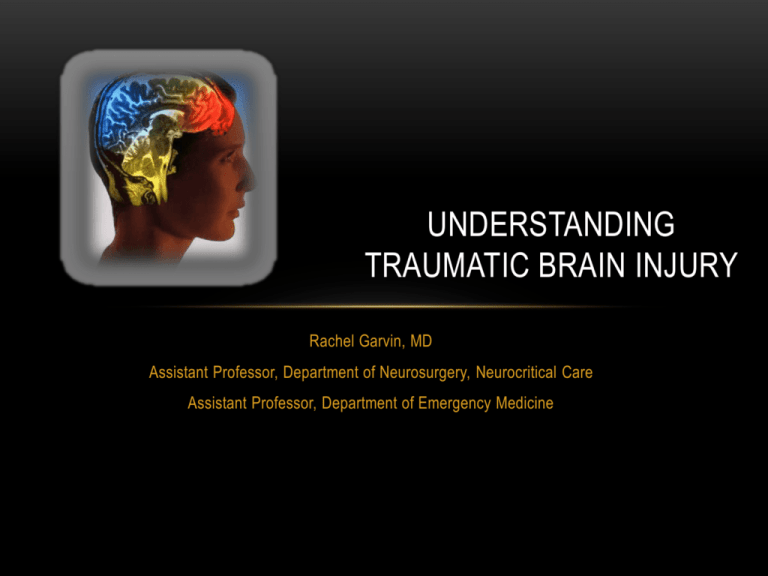
UNDERSTANDING TRAUMATIC BRAIN INJURY Rachel Garvin, MD Assistant Professor, Department of Neurosurgery, Neurocritical Care Assistant Professor, Department of Emergency Medicine OUTLINE • Statistics • Defining TBI • Secondary injury • Management strategies TBI STATS • 2 million TBI’s treated each year in US, one every 15 seconds • Up to 2% of US population living with TBI • Leading cause of M&M in ages 1-44 • Single severe TBI victim can generate 4 million dollars in lifetime costs • Adults ages >75 have highest rates of TBI related hospitalization and death • 70-90% of TBI worldwide are considered “mild,” 1% of those require a surgical intervention http://www.cdc.gov/traumaticbraininjury/data/rates.html http://www.cdc.gov/traumaticbraininjury/data/dist_ed.html CLASSIFICATION OF TBI • Pathoanatomic • Physical Mechanism • Pathophysiologic • Injury Severity Pathoanatomic Epidural Subdural Subarachnoid Contusion Axonal injury KNOWING ANATOMY IS IMPORTANT PHYSICAL MECHANISM • Impact vs Inertial loading INJURY SEVERITY • GCS • 13-15 Mild TBI • 9-12 Moderate TBI • <8 Severe TBI PATHOPHYSIOLOGIC • Primary Injury • Immediate damage done • Secondary Injury • Excitotoxic cascade • Potentially avoidable factors • Hypoxia, hypotension, hypercarbia, hyponatremia, seizures SECONDARY INJURY GLUTAMATE’S TOXIC EFFECTS TIME MATTERS GOALS OF TBI MANAGEMENT • Preventing secondary injury • ICP • CPP • Neuroprotection • Good neurologic recovery PREVENTING SECONDARY INJURY • Keeping things “normal” • Avoid processes that increase CMRO2 • Avoiding processes that increase ICP • Maintain CPP CEREBRAL METABOLISM • CMRO2 rate 3.5ml/100g/min • Accounts for 20% of O2 consumption at rest • Average blood flow of 50ml/100g/min • CBF <20ml/100g/min = risk for permanent neurologic damage • CBF <10ml/100g/min = neuronal death • Uses glucose as primary substrate • >90% glucose consumption is oxidative • <5% metabolized to lactate • <1% ketones and others FICK EQUATION • CMRO2 = CBF x AVDO2 • AVDO2 = CaO2 – CjvO2 • CBF = CPP/CVR • CMRO2 = cerebral metabolic rate of oxygen • AVDO2 = arterio-venous difference in oxygen CEREBRAL AUTOREGULATION BRAIN COMPLIANCE CAUSES OF INCREASED ICP • Intracranial • Extracranial • Hematomas/Contusi ons • Hypoxia • Ischemia • Hyper/Hypotension • Hydrocephalus • Increased CBF • Hypercarbia • Head rotation • Fever • Seizure • Increased intraabdominal pressure DO WE NEED TO MONITOR ICP DOES MONITORING ICP IMPROVE OUTCOMES • Multicenter, randomized, parallel-group trial • ICP monitor vs imaging and clinical exam • Inclusion: >13, GCS 3-8 • Groups stratified up by age and severity of injury • Baseline CT, 48 hours and 5-7 days • 6 month outcomes with 21 components MANAGEMENT OF TBI • ABC’s • Preventing secondary injury • ICP management • Emergent therapies ABC’S • Airway • Avoiding hypoxia • RSI • Post-intubation sedation • Breathing • Normocarbia • Circulation • Avoiding hypotension TIERED APPROACH TO ICP MANAGEMENT • Positioning • Sedation • Fentanyl, Propofol, Ketamine • HTS vs Mannitol • Pentobarbital • Surgery • Literature review • Primary outcome: ICP post-ketamine • Secondary outcome: CPP, MABP, patient outcome, AE • Level of evidence assessment (Oxford and GRADE) • 371 articles 7 articles • 4 studies with continuous infusion RESULTS • Continuous Infusion: • ICP: no clinically significant difference • CPP and MABP: 2 studies no difference; 2 studies increase • Bolus Dosing: • ICP: no increase; trend towards decrease • CPP and MABP: 2 no effect documented; 3 rd increase CPP and decrease MABP LEVELS OF EVIDENCE • GRADE level of evidence: • 2 studies GRADE B • 4 studies GRADE C • 1 study GRADE D • Oxford level of evidence: • 6 studies level 2b • 1 level 4 Recommendations: Oxford 2b, GRADE C level of evidence to support that ketamine does not increase ICP ICP MONITORS Most often placed within ventricle or brain parenchyma • Waveforms P1-P3 • P1: percussion wave • Reflects arterial pressure transmitted through choroid • P2: tidal wave • Represents cerebral compliance • P3: dicrotic wave • Represents venous pressure MULTI-MODAL MONITORING • PBtO2 • Microdialysis • Brain Temperature Monitoring • SjvO2 • CBV EMERGENT TREATMENT • Hyperventilation • Decompressive Hemicraniectomy HYPERVENTILATION • Decreased PaCO2 alkalinizing CSF cerebral vasoconstriction • Decreased CBV decreased ICP • Effects last around 15 hours until CSF pH equilibrates • Then there is re-dilation of cerebral arteries rebound ICP MANNITOL VS HYPERTONIC SALINE • Mannitol • HTS • Rheologic and osmotic effects • Rheologic and Osmotic effect • Osmotic effects • Can be used in hypovolemic pts • Crosses BBB • Contraindicated in hypovolemic pts • Can cause hyperchloremic acidosis HYPEROSMOLAR THERAPY DECOMPRESSIVE HEMICRANI • For expanding lesions associated with declining neuro status • Prophylactic • Need cranioplasty later on DECOMPRESSIVE HEMICRANI • Used since the 1970’s • Mostly salvage technique • DECRA trial 2011 DECOMPRESSIVE HEMICRANI OTHER THERAPIES • Hypothermia • Progesterone • ProTECT III -> results now showed no improvement • Statins • Citicoline • Cyclosporine A PREDICTING OUTCOMES • Clinical predictors: • Age, post-resuscitation GCS, hypotension, hypoxia, pupils, multi-system injury • Radiologic Predictors: • Absent basal cisterns, midline shift, SAH, brainstem injury • CRASH and IMPACT prognostic scoring SUMMARY • TBI is common and severe TBI can have devastating consequences • Controlling secondary injury and the excitotoxic cascade are imperative • ICP, CPP and multi-modality monitoring helpful but data limited • Hypertonic saline for hyperosmolar therapy • Surgery is an option • Prognosis is challenging QUESTIONS? REFERENCES • Bazarian JJ, McClung J, Cheng YT, Flesher W, Schneider SM. Emergency department management of mild traumatic brain injury in the USA. Emerg Med J 2005; 22:473-477 • Brain Trauma Foundation. Guidelines for the Management of Severe Traumatic Brain Injury. Journal of Neurotrauma 2007; 24 • Chestnut RM et al. A Trial of Intracranial-Pressure Monitoring in Traumatic Brain Injury. N Engl J Med 2012; 367: 2471-81. • Le Roux et al. Consensus Summary Statement of the International Multidisciplinary Consensus Conference on Multimodality Moni toring in Neurocritical Care. Neurocrit Care. Published online 11 September 2014. • Marguiles S, Hicks R. Combination therapies for traumatic brain injury: Prospective considerations. Journal of Neurotrauma 2009; 26:925939 • Meixensberger J, Jaeger M, Vath A, Dings J, Kunze E, Roosen K. Brain tissue oxygen guided treatment supplementing ICP/CPP therapy after traumatic brain injury. J Neurol Neuroaurg Psychiatry 2003; 74:760-764 • Rangel-Castillo L, Gopinath S, Robertson C. Management of intracranial hypertension. Neurol Clin 2008 May; 26(2): 521-541 • Roberts et al. Sedation for critically ill adults with severe traumatic brain injury: A systematic review of randomized cont rolled trials. Crit Care Med 2011; 39(12): 2743-2751 • Roozenbeek et al. Prediction of Outcome after Moderate and Severe Traumatic Brain Injury: External Validation of the IMPACT and CRASH Prognostic Models. Crit Care Med 2012; 40(5): 1609-1617 • Saatman KE, Duhaime AC, Bullock R, Maas A, Valadka A, Manley GT. Classification of traumatic brain injury for targeted therapies. Journal of Neurotrauma 2008; 25: 719-738. • Sterr A, Herron K, Hayward C, Montaldi D. Are mild head injuries as mild as we think? Neurobehavioral concomittants of chronic postconcussion syndrome. BMC Neurology 2006: 1471-2377 • Spiotta AM, Stiefel MF, Gracias VH, Garuffe AM, Kofke WA, Maloney-Wilensky E, Troxel AB, Levine JM, Le Roux PD. Brain tissue oxygendirected management and outcome in patients with severe traumatic brain injury. J Neurosurg 2010: 113: 571-580 • Thompson HJ, McCormick WC, Kagan SH. Traumatic brain injury in older adults: Epidemiology, outcomes, and future implications. • Torre-Healy A, Marko NF, Weil RJ. Hyperosmolar Therapy for Intracranial Hypertension. Neurocrit Care 2012; 17: 117-130.
